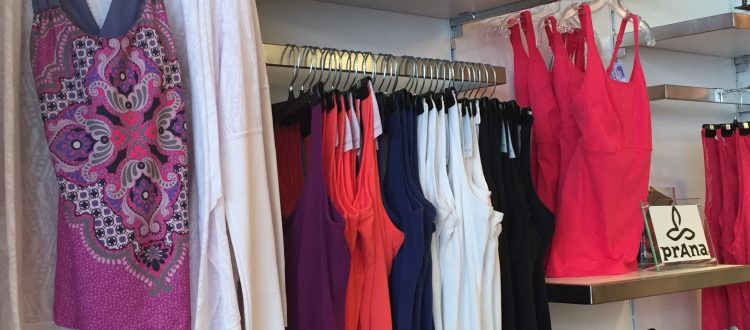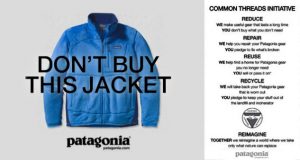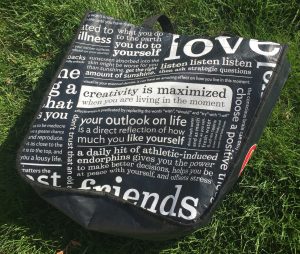Working out the sustainability of work-out wear
Active wear is a growing segment of the apparel market, especially since more and more people are wearing their active-wear also as casual wear. There are various sustainability angles to consider with this sector, for example textile waste is a hot topic (see SWS post about textile recycling). As greater awareness builds about textile recycling (only 15% of textile waste is currently diverted from landfill, whereas 93% could be reclaimed, recycled or repurposed), I was thinking that many people wouldn’t feel comfortable placing their workout wear in the donation bin. Let’s face it, worn out work-out wear may not look (or smell) so attractive…who would want it?
Can active wear be recycled?
I attended a Textile Waste conference last May, and was fortunate to be sitting next to a veteran in this industry, Mary Jean O’Donnell of MJ Waste Solutions, who has been a waste consultant for 25 years. She told me the issue with active-wear is that they are often made with high-tech, proprietary materials which may be difficult to break down. However, Mary Jean did mention that it’s still best to recycle in the donation bins because the textile waste companies will still do their best to divert these garments from landfill.
What about the ‘S’ factor?
At the textile conference, it became clear that all garments should be clean and dry when placed in the bins. Hmmm, so what about work out wear – it’s often difficult to have that fresh, clean smell (the ‘s’ factor) even after cleaning? Interestingly, I came across an article in Refinery29 that explained that typical laundry detergent alone may not work, so one should first spray them with a mild bacteria killer like vinegar, vodka or tea tree oil. If cleaned properly, perhaps the clothes will last longer and not even need to be donated/ recycled.
In addition, look for high-tech fibers with antimicrobial treatments such as silver such as lululemon’s Silverescent technology.
Who is taking the lead in the active-wear sustainability race?
As I learn more about sustainable fashion, it has become apparent that everyone is supportive and collaborative, as opposed to competitive. In my mind, active-wear can be categorized into 3 groups: The ‘outdoorsy’ brands like Patagonia who have been considering the impact of the environment from the onset of their business; The mega workout brands like lululemon who are investing heavily in innovation; and the smaller eco-brands that have built their business with sustainability in mind.
The ‘outdoorsy’ brands – Patagonia and Canadian brand MEC (Mountain Equipment Co-op) , are leaders in sustainable manufacturing and I believe these brands have been paving the way for sustainable fashion as an industry. Many have been activist in environmental causes and were speaking about ‘recycled’ and ‘organic’ fabric way before most fashion companies had it on their agendas. They had ‘tech’ active wear that you could wear for days on end – a pair of hiking pants lasted me for 8 days of trekking in Nepal, no problem. These brands continue to lead the sustainable movement with innovative fabric technologies and investments in sustainable fashion practices. Patagonia, even went as far as producing an ad campaign “Don’t buy this jacket”.
The mega work-out wear brands – I will use lululemon as my example, because (as you can likely tell by now), I am very loyal to them. I have been shopping there shortly after they opened their 1st Toronto store in the early 90s. I have a black jacket that has travelled the world with me and I didn’t realize I had such an emotional attachment until I thought I lost it (and then happily found it) – definitely more than #30wears, more like #300wears.
Luluemon is investing heavily in innovation and technology. In terms of textile waste, they work with debrand, a company that takes scraps and merchandise that ‘doesn’t make the cut’ and recycles them. They are also doing a great job educating the mainstream consumer about health and wellness in their stores and now sustainability (however, this seems to be mostly online). They (and other mass retailers) have the ability, with their extensive brick and mortar locations plus their customer databases, to communicate directly with the consumer about making more conscientious choices. What I would also like to see with these type of brands, is to take one step further and have ‘work-out’ recycling bins in their stores – to take the stigma out of recycling work out wear.
Smaller eco-brands – It has been exciting to see so many new eco-brands come up on social media. Prana has now moved into the larger realm with more mass appeal. They use sustainable fabrics in most of their items, commit to fair labour practises and are concerned about overall waste reduction, including their packaging. A couple of other brands I came across were Teeki and Yoga Democracy, however, I thought it would be a better idea to link to a blog by a fitness expert, Amber Larsen who chose her eco-brands based on testing them out.
The issue for these smaller eco-brands is getting the product out to the marketplace to have an impact. Personally, I think the smaller brands have an important role to play. They tend to be more entrepreneurial and can push the envelope on traditional approaches. Some of the most fashion forward, high-tech active wear are the smaller brands. Without the need for bricks and mortar and with marketing via social media influencers, they don’t necessarily have to be big to be profitable and sustainable (from a business point of view).
Overall, there is a lot of sustainable ‘activity’ happening with ‘active-wear’. Each category brings a lot to the table and both big and small companies can hopefully further collaborate to learn from each other. The larger companies can make major investments in innovative technologies, communicate in a large scale to educate consumers about conscientious consumption, and have a major influence on the supply chain. The smaller companies can continue to gain momentum with consumer interest to help keep the larger competitors on their toes. As a smaller, nimble company, they will continue to be innovative, take risks and think ‘outside of the box’.
As a consumer, you can look to consider fabric choices that are technically advanced so they can last longer and/or ideally be made of recycled or sustainable fabrics. In addition, ensure you clean your garments properly for an active life so they last as long as possible. Finally, when you are done, clean them and place in donation bins – the experts in the textile recycling business will do their best to keep them out of landfill.
If you have further thoughts about this topic, or specific brands you would like to highlight, please add in comments below. Thank you for your time…now go for a run! Stacey.
Featured photo was taken at Sporting Life in Toronto showcasing the Prana line. Please note, Style with Substance blogs are non-sponsored.









I think Merino wool is a great solution for active wear that lasts long, avoids odor, reduces the number of times you need to wash it once you get it home. What Icebreaker is doing is exciting in this area. I’m concerned about the nano-silver technology yet. They are small enough to enter DNA.